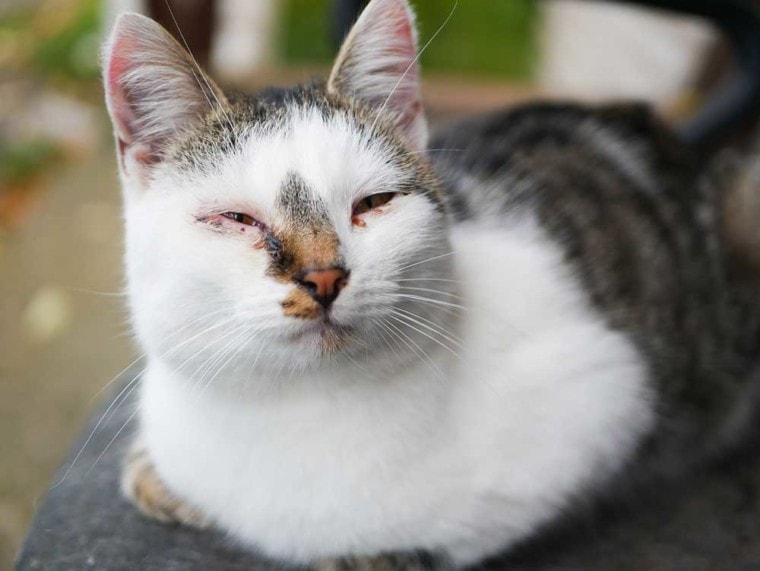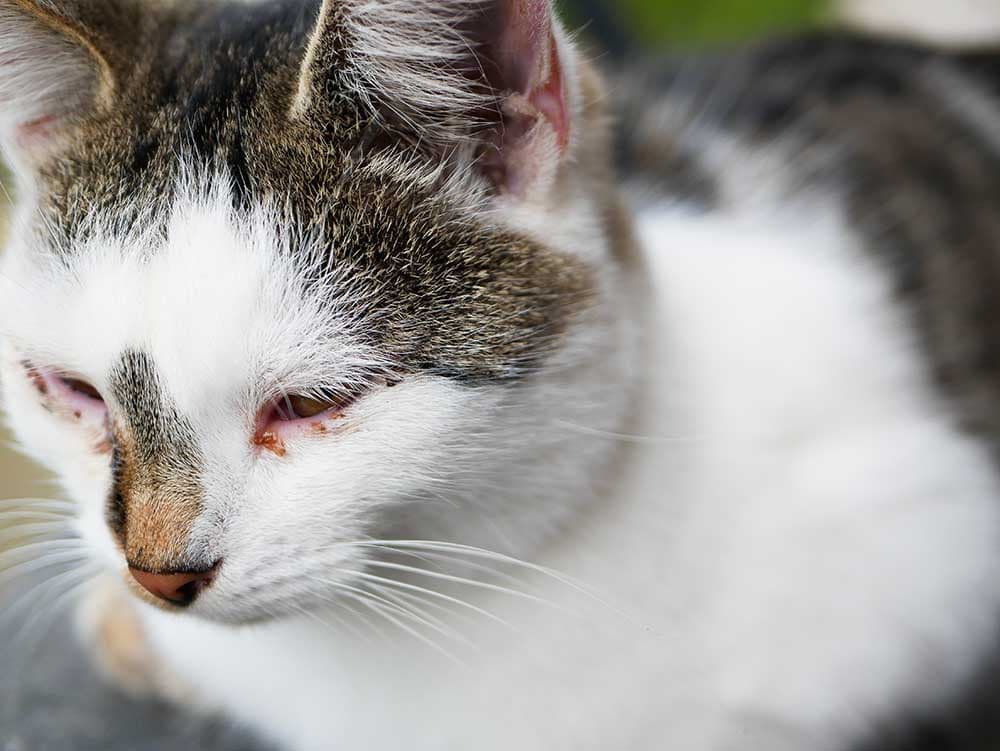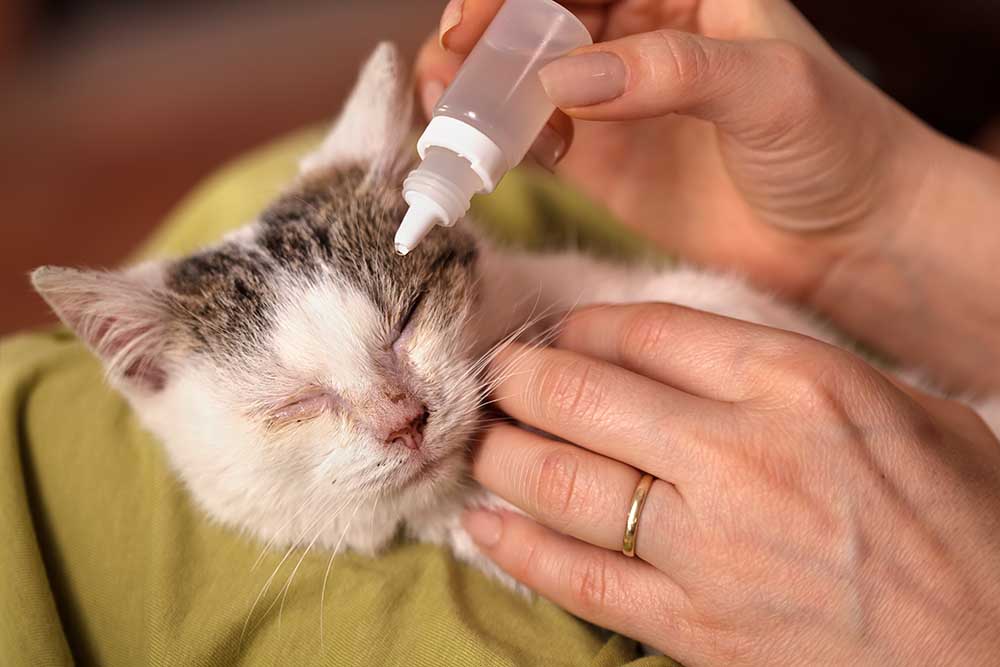
Cats can get conjunctivitis, just like people can. This condition is characterized by the swelling of a cat’s conjunctiva, which is the mucous membrane in the cat’s eye. Typically, the conjunctiva is not visible. However, when it becomes infected and swells, it begins to pop out and become visible.
This condition can occur in both eyes or just one eye.
Either way, this disease usually requires veterinary care. Fortunately, it is easy to spot and usually doesn’t lead to any long-term problems.

Causes of Conjunctivitis in Cats
There are several causes of conjunctivitis. For one, it can be caused by an infectious disease. This kind is caused by bacteria, viruses, fungi, or parasites. Most commonly, the feline viral rhinotracheitis and feline calicivirus can both cause conjunctivitis initially. These conditions can be serious if not treated, which makes taking your cat to the doctor even more essential as soon as you notice signs.
Bacterial infections can also cause this problem. Sometimes, these show up after the initial viral infection. Other times, they’re the cause of the condition.
However, conjunctivitis can also be caused by non-infectious reasons — for instance, allergies and seminal environmental reasons. If something can irritate your cat’s eye, it can potentially cause the conjunctiva to swell.
Sand and dust can become trapped in the eyelid, or certain chemicals may irritate the eye. These can even open up the eye to a secondary infection.
Hereditary conditions and tumors can also cause conjunctivitis. However, these causes are less common than others. Himalayans and Persians seem to be more likely to develop entropion, which occurs when the eyelid turns inward. When this occurs, it can irritate the eyeball and cause conjunctivitis.

Signs of Conjunctivitis
Typically, the most obvious sign of conjunctivitis is the appearance of the conjunctiva. This is why this condition is called “pink eye.” However, there are other signs.
For instance, tearing and watering from one eye is a common sign and typically occurs earlier than other signs. Discharge can also occur. Cats often become sensitive to light and may keep their eyes closed or only partially open.
In serious cases, the third eyelid may swell and cover the rest of your cat’s eye. If this occurs, your cat needs to see the vet as soon as possible. While severe complications don’t typically occur, they can if your cat is not properly taken care of.

Diagnosis
Typically, diagnosing conjunctivitis occurs when there doesn’t seem to be another reason for the “pink eye” sign. Vets will rule out factors like a foreign body in the eye or a blocked tear duct if these don’t seem to be the cause.
There are specific tests that can confirm conjunctivitis. However, these are typically not done unless a definite diagnosis needs to be made.
If the cat’s condition doesn’t improve, then a test may be run to figure out the exact cause of the conjunctivitis.

Treatment
There are several treatments for conjunctivitis. It depends on the cause of this condition, as different medications will treat different bacteria or viruses. However, the exact cause isn’t always known. Therefore, antibiotics and anti-inflammatory drugs are often used.

Allergic Conjunctivitis
If the condition is caused by allergies, a topical corticosteroid ointment or drops may be used. These can reduce swelling and itchiness. Different medications may be used if your cat has other allergy signs.
Herpesvirus Conjunctivitis
In mild cases, this condition usually occurs on its own, and no treatment may be required. However, it isn’t odd for infected cats to regularly have relapses. Therefore, your feline may get conjunctivitis repeatedly.
L-lysine can be recommended to improve your cat’s immune system, which may prevent further relapses. Antibiotics are sometimes necessary to prevent secondary bacterial infections or treat existing ones. Interferon-alpha may also be suggested because it is another immune stimulant.
In serious cases, antiviral medications may need to be used. Some cats may need more help than others.
Bacterial Conjunctivitis
In the case of a bacterial infection, your feline may need antibiotics. Eyedrops or an ointment are often also used to prevent inflammation and reduce pain.

How Long Does Conjunctivitis Take to Get Better?
In many cases, conjunctivitis takes a few days to get better. Your feline will need to finish the entire round of antibiotics in order to be completely cured, however. Stopping the medication too soon may cause the infection to come back, and it will often be worse. Over time, antibiotic-resistant bacteria can make infections extremely difficult to treat.
Prognosis
The prognosis for cats with conjunctivitis is quite good. In many cases, your feline will be better within a few days, even without treatment. With treatment, you should notice an improvement quickly.
However, flare ups can occur from time to time, especially if your cat’s immune system is affected. In this case, the goal should be to minimize the frequency of the flare ups. Good nutrition and proper vaccination are required to prevent flare ups.

Conclusion
There are several causes of conjunctivitis. The treatment depends largely on the cause. If the cat has a bacterial infection, they will likely need antibiotics, for instance. However, they may need antivirals in some other cases.
The most common sign of this condition is inflammation and redness in the eye. If other causes have been ruled out, conjunctivitis is often diagnosed.
Most cats get better quickly and severe complications are rare. However, some cats do end up with flare ups that will regularly occur. In these cases, you may need to consider immune-supportive therapies.
See also:
- FIV in Cats: Symptoms, Causes, Treatments & Prevention
- Why Do Cats Have Eye Boogers? What Is Cat Eye Discharge?
Featured Image Credit: KAY4YK, Shutterstock






